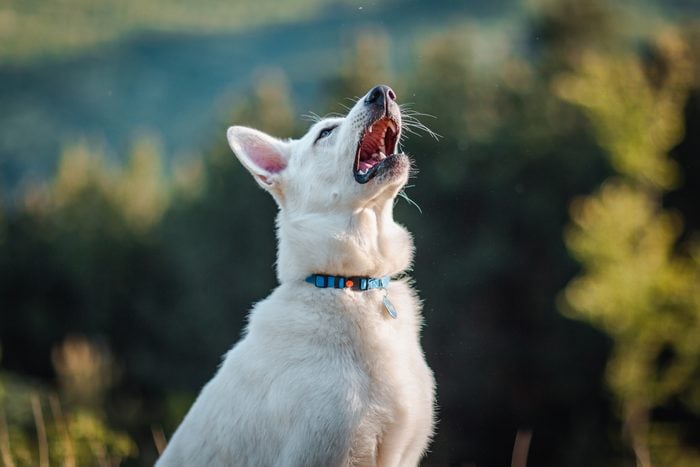
When my husband and I adopted our first dog, a Labrador retriever mix named Rio, I thought the only dog language was barking. What a revelation to realize barking was just the tip of the iceberg—and even that communication is highly nuanced. For instance, Rio would bark to go outside, to greet new friends or in frustrated anticipation if he thought someone was being too slow to pop a Champagne cork for him to fetch. (Some dogs do the same thing when they want someone to throw a ball, of course—to each its own!)
Rio could also whistle in his throat to make a sound we called “steam kettle” and would make guttural sounds like Chewbacca from Star Wars. When we adopted a miniature poodle mix named Peach, she introduced new dog sounds. She would race past me up the stairs, look down at me from the top and throw her head sideways into a proud sneezy snort as if to say, “That’s right! I beat you to the top, and I am the best dog ever!”
Learning to communicate with another species is one of the most profound experiences of my life—and a big reason I narrowed my focus as a journalist to pets after adopting Rio back in 2010 and later became president of the Dog Writers Association of America. I love learning about the key parts of dog language, from dog facial expressions and overall body language to wonderfully weird dog noises like laughing and even purring. Our pets are communicating with us all the time; we just have to pay attention.
“We would all benefit from understanding what our dogs are saying,” says veterinarian Nicholas Dodman, BVMS, co-founder of the Center for Canine Behavior Studies. “They make a variety of sounds, and all of them mean something. Learn to speak dog, and you two will be better connected.” Ahead, you’ll find some of the common dog noises you might hear from your pet and learn from canine experts what this dog behavior means.
Get Reader’s Digest’s Read Up newsletter for more pet insights, humor, travel, tech and fun facts all week long.
About the experts
|
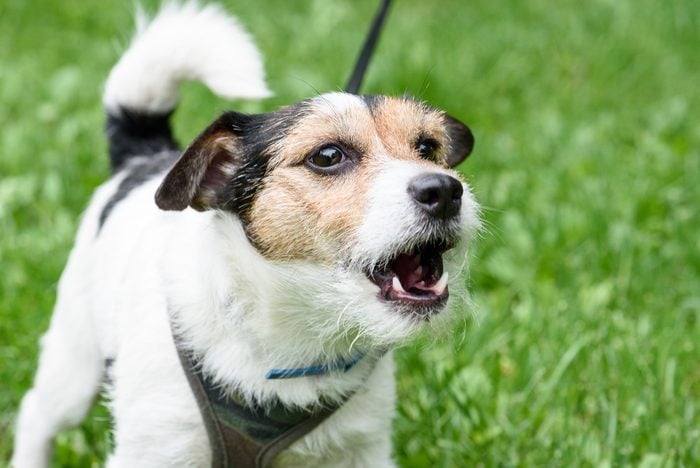
Barking
Barking is probably the best known of all dog noises, but like most dog sounds, it can mean different things depending on tone, frequency, body language and the situation, according to veterinarian Paige Andersen, DVM, managing partner of TimberCreek Veterinary Hospital.
For example, when dogs are “out of their comfort zone” in the exam room, they might emit a low, deep, loud bark when a veterinarian enters the room. The dog’s body might be stiff, and it may lock eyes on the veterinarian and position itself between the veterinary professional and the owner.
“Lots of times, that is a warning bark, or they’re being protective of their owner,” Dr. Andersen says. “What we don’t want to do is match their eye contact. We give them space. We don’t try to touch them. We might toss some treats on the ground as we’re talking to the owner until they become more comfortable and learn we aren’t a threat.”
In contrast, excited dogs might emit a higher-pitched bark while their tails are wagging and eyes are bright. My brother’s cocker spaniel mix, Nice, would repeatedly release an ear-splitting “sonic bark” whenever he wanted someone to toss him a ball. Barking can also be a sign of boredom, so be sure to offer your dog plenty of exercise and enrichment activities.
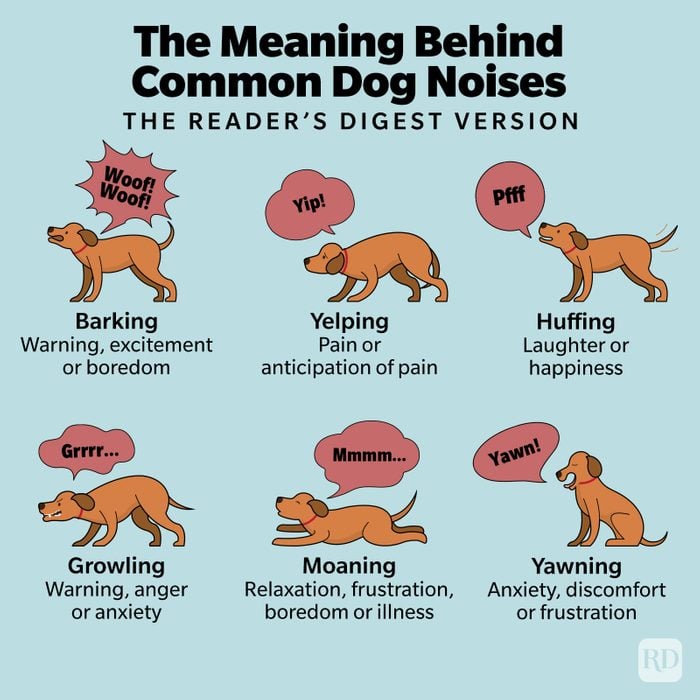
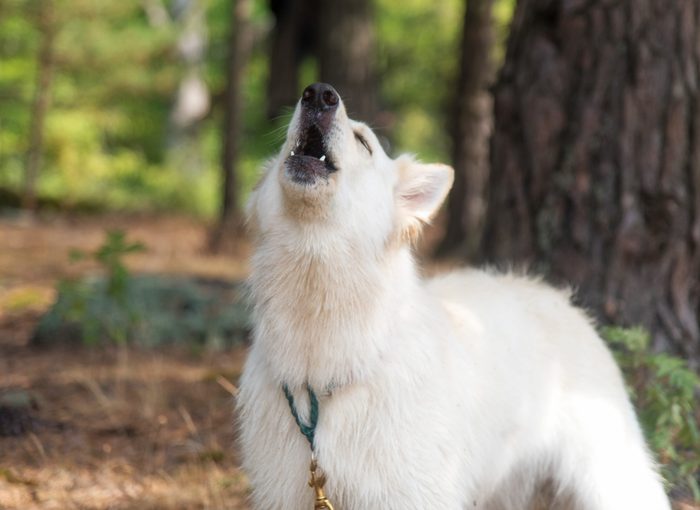
Howling
Howling is a long-distance form of communication tracing from domestic dogs back to wolves, according to Dr. Dodman. A wolf would stand on a hillside, possibly with its pack, and raise its head, purse its lips and emit a long howl—which could immediately be answered by a wolf on the other side of the valley. “It’s sort of vocal smoke signals,” he explains.
It can also be an almost knee-jerk reaction when dogs hear certain tones, like the pitch of an ambulance siren or a guitar chord. When Dr. Dodman lived in the United Kingdom, one of his friends had a dog named Djelias. The owner would say, “Djelias, do us a wee tune.” The dog would jump onto the piano stool and start hammering on the keys and—when he hit certain notes—start howling as though he were singing.
Our Labrador retriever mix, Rio, loved howling with us and our neighbors here in Denver in the early days of the coronavirus pandemic, when residents would howl each night at 8 p.m. to thank health care workers and first responders. Our loyal dog would stare at us while he howled and encourage us to keep crying out even as other howls in the neighborhood petered out. He seemed to think it was a fun group activity for our “pack.”
Interestingly, research has found a genetic link to howling: Ancient dog breeds like Akitas, Alaskan malamutes and Salukis are more prone to howling, like their wild ancestors.
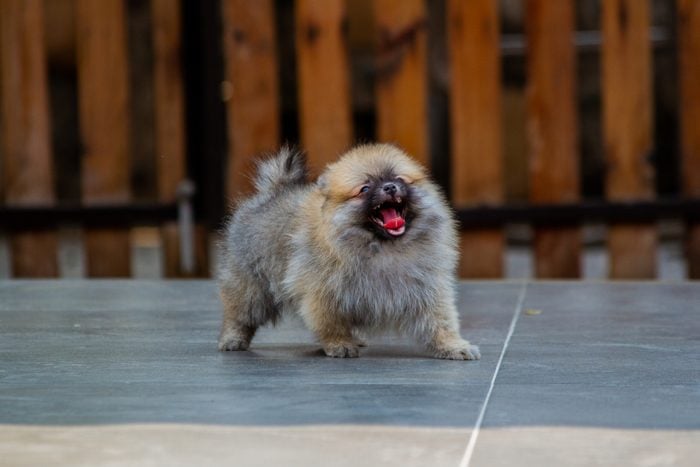
Yelping
My husband learned to drag his feet in the kitchen so he wouldn’t accidentally step on our 9-pound poodle mix, Peach, and hear a yelp of surprise or pain. The tiny dog would be so focused on catching any food that might fall to the floor that she’d ignore her personal safety by getting underfoot.
“Yelping is never a positive sound for a dog,” says Dr. Andersen. “Yelping is the sharp, high-pitched, short sound. It’s loud. I guess you could say it’s like a scream in a dog.”
Usually, dogs yelp when they feel pain or are anticipating pain, according to Dr. Andersen. So when you hear a yelp, stop whatever you’re doing that caused the dog to yelp. Gently set the dog on the floor or get it to a safe place. If you continue to see signs your dog is in pain, contact your veterinarian.
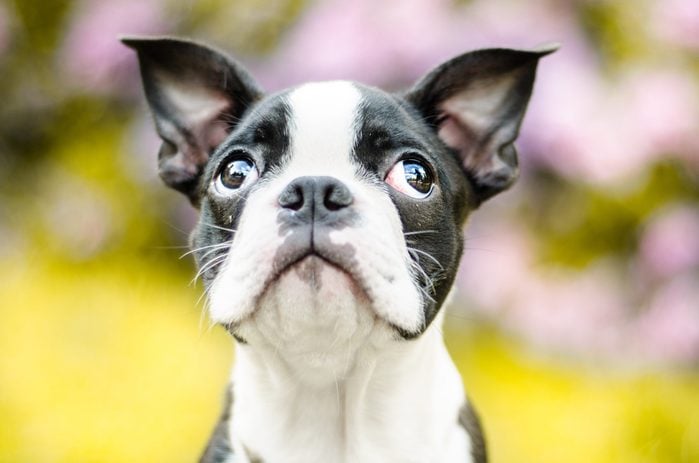
Whining
Whining is another example of dog noises that can have multiple meanings, according to Dr. Andersen. “Usually, it is more of a drawn-out, high-pitched sound. It can be quiet or loud. Lots of times, it’s a repetitive sound,” she says. “It can frequently mean discomfort: They might be painful somewhere, or they might need to go out to potty.”
It can also be an attention-seeking dog language. For instance, if your dogs are kenneled and would like to get out of their crate, you might hear plaintive whining signaling boredom or anxiety.
Dog whining can also communicate excitement. Rio used to whine as we’d approach another dog because he couldn’t wait to say hello with a quick butt sniff and friendly gestures like a wagging tail.
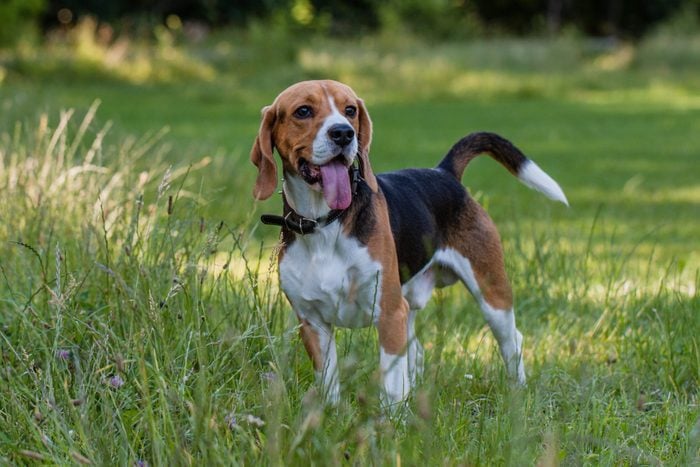
Huffing
When a dog huffs, you’ll hear it make small exhalations of air through its mouth (not its nose). That airy sound is the canine equivalent of laughing. Decades ago, researchers started sharing recordings of dogs huffing with animal shelters to help calm and quiet shelter dogs.
“We always think dogs don’t laugh, but they do,” says Dr. Dodman. “It is a happy sound, so if you play happy sounds, the dogs realize that it’s fun and there’s nothing to worry about. It’s the same for us: If you’re sitting in a room full of people laughing, you automatically feel drawn in and in a good mood.”
It is possible that a dog might huff after accidentally inhaling a small foreign body in an attempt to expel it from its windpipe, he notes. In those instances, the huffing might be less frequent and seem more purposeful, and the dog’s body language won’t be relaxed and happy.
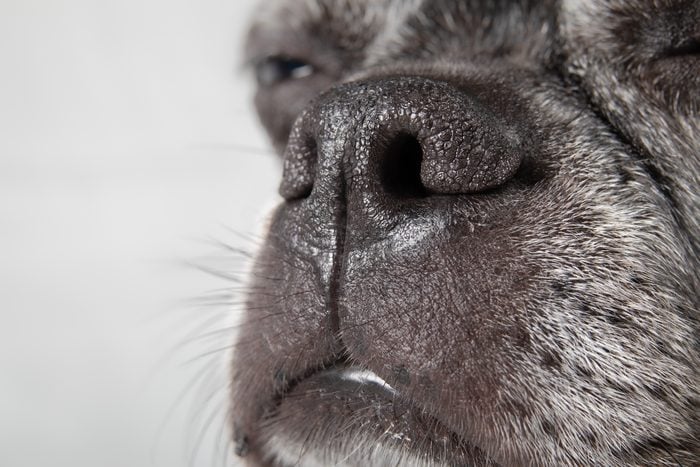
Snorting
Unlike huffing, snorting is an exhalation through the nose. Dr. Dodman’s dog, Rusty, likely a black mouth cur, snorts whenever he smells a particular odor while sniffing long grass near their home. While snorting, Rusty will shake his head. “He’s trying to clear his nose that way, just like we might blow our nose with a handkerchief,” Dr. Dodman says.
Snorting is very common in brachycephalic breeds with snub noses, like Pekingese, pugs, Boston terriers and bulldogs. It can be indicative of health issues ranging from a nasal infection to breathing issues caused by brachycephalic obstructive airway syndrome (BOAS).
As I wrote that last sentence, my Yorkshire terrier mix, Tux, propped his front paws on my knee to remind me it was time for his walk. I looked at him and asked in a high-pitched voice, “Do you want to go for a walk?” He responded by excitedly running around in a circle and letting loose a delighted little snort—a well-timed reminder that with dog language, context is everything.

Growling
Growling is a not-so-secret clue that a dog is mad at you (or someone else) or is feeling anxious. The low, rumbling sound that’s almost under the breath is often accompanied by a lip that’s raised and ears that are pricked forward. It’s often a warning, according to Dr. Andersen.
“Similar to the warning barks that they give, if they’re growling, avoid eye contact,” she advises. “Hands off. Give them space.”
Avoiding eye contact with a growling, staring dog helps defuse the situation. “When they have their eyes locked on you, they’re trying to establish dominance, and that’s not something we need to match,” she says. “It can be challenging and threatening. Our goal is to always respect their boundaries and get them to a place of trust.”
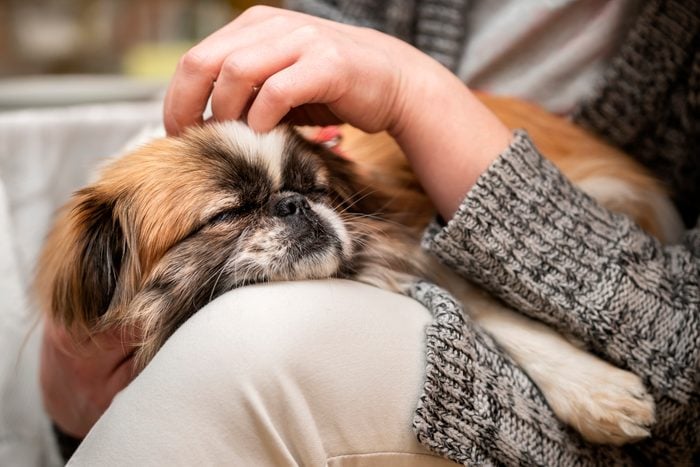
Moaning
A dog may issue a low moan for a variety of reasons, so Dr. Dodman says it’s one more reminder to “read the whole dog.”
“You could be petting a dog, and he’s lying there, eyes flickering shut, the body totally relaxed, going, ‘Aah.’ It’s almost like he’s really enjoying a back rub,” he says. “So they can do it when they’re happy.”
Dogs also might moan when they’re frustrated, like if they’re not being heard or attended to in a way they like. For instance, Dr. Dodman watched a video of a poodle moaning in frustration when it wasn’t allowed to chew on a chicken wrapper.
Additionally, he says dogs might moan if they’re bored (if that’s the case, you might try offering puzzle toys) or if they’re unwell.
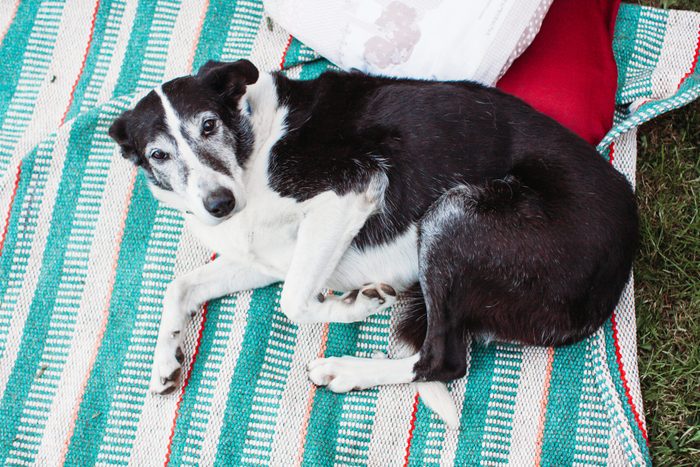
Grunting
While a moan is often sustained, a grunt is typically a short, guttural sound. When Rio was a senior dog with arthritis, he would grunt once whenever he lay down. So we invested in an orthopedic bed and veterinary treatments to help make him more comfortable.
Similarly, when Dr. Dodman’s wife, who is also a veterinarian, lifts their dog, Rusty, into a car, the pup stays silent. But they’ve noticed that Rusty grunts whenever Dr. Dodman lifts him. “We both think Rusty’s sort of uncomfortable,” he says. “I’ve got to learn her technique.”
Paying attention to the ways our dogs communicate with us and making changes to meet their physical, mental and emotional needs is one way people can say “I love you” in dog language.

Yawning
Yawning is one of those often-misinterpreted dog sounds, according to Dr. Andersen. “A lot of times, yawning in our dogs is because of anxiety or frustration,” she says. “It can mean they’re tired, but unless they have all four paws up and they’re stretching out and just woke up from a big nap, usually if they’re yawning, it’s because they are uncomfortable with the situation.”
Yawning is a particularly important sign for parents to take note of when small children are interacting with dogs. For instance, Dr. Andersen has two young daughters, and when they visit friends with pets, she’ll sometimes see a dog on the couch yawning while the kids are running around. It’s a subtle sign, but it’s a clue that the dog is feeling uncomfortable—especially if it leads to other stress signs, like whale eye (wide eye with whites of the eyes exposed) or growling, which could culminate in biting. Sometimes even the best dog breeds for kids need a break from the action.
“I’m a huge advocate of crate-training dogs or having a room in the house that is their space that they can go into and you can make off-limits when you have company over,” Dr. Andersen says. “When they start showing these signs, it’s best to not put a dog in that situation [interacting with company] at all to keep everyone safe.”
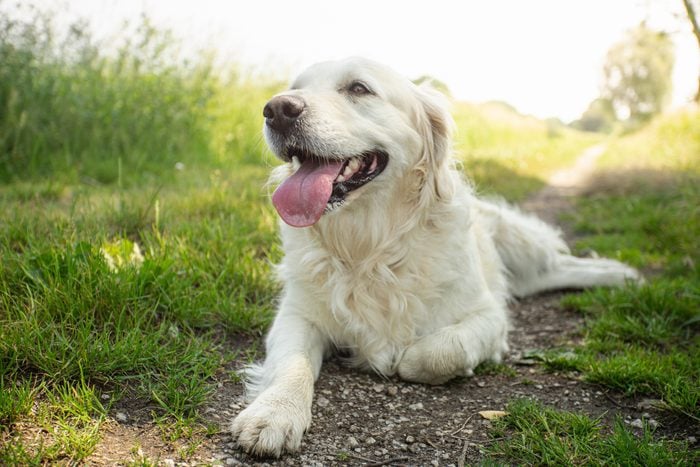
Panting
Sure, dogs pant to cool off, aka “thermoregulate,” when they’re hot, but they also pant when they’re anxious, according to Dr. Andersen. “Lots of times with anxious panting, we see wider eyes,” she says. “They might be looking around and being hypervigilant about what’s going on around them.”
On the flip side, if a dog is panting while whining excitedly, it might be overwhelmed with excitement. Complicating matters further, panting excessively or to the point of difficulty breathing can also be a sign your dog isn’t feeling well and is possibly experiencing pain, she notes. Know your dog, and keep an eye on the situation.
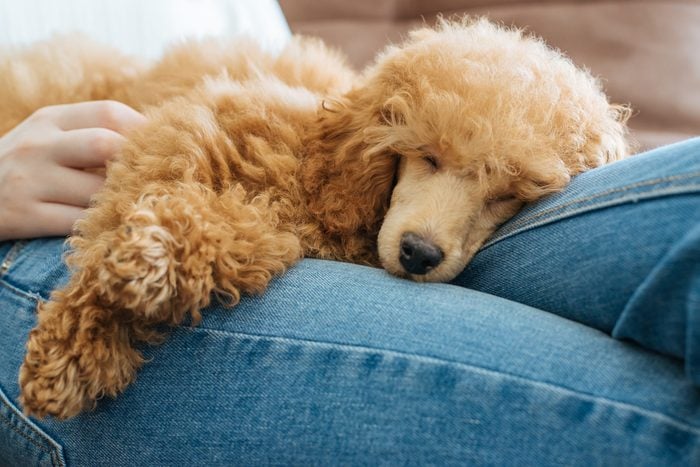
Purring
While cats are famous for purring, it’s natural to wonder, Do dogs purr too? The answer is yes, according to Dr. Dodman. “The noise they make is very much like purring: It’s one of deep satisfaction,” he says. “It’s a happy, contented sound when basically they vibrate the larynx.”
I’ve actually heard dogs purr, though I didn’t give it the label at the time. Our little poodle, Peach, used to purr contentedly with staccato vibrations when we’d pet her as she snuggled in a lap. “The cooing of a dove!” we’d declare.
Our friends’ Rottweiler, Soren, would purr when he was happy during playtime. In fact, in addition to being known as one of the smartest dog breeds, Rottweilers famously have a distinctive “Rottie rumble.” The low rumble almost sounds like a growl, but when they’re happy, it means, “This is fun!”
Why trust us
At Reader’s Digest, we’re committed to producing high-quality content by writers with expertise and experience in their field in consultation with relevant, qualified experts. For this piece, Jen Reeder tapped her experience as a longtime pet journalist and former president of the Dog Writers Association of America, and then Wailani Sung, DVM, a vet with a board certification in veterinary behavioral medicine who owns Bay Area Vet Behavior, gave it a rigorous review to ensure that all information is accurate and offers the best possible advice to readers. We verify all facts and data, back them with credible sourcing and revisit them over time to ensure they remain accurate and up to date. Read more about our team, our contributors and our editorial policies.
Sources:
- Nicholas Dodman, BVMS, DACVB, DACVAA, professor emeritus at Tufts University, co-founder and CEO of the Center for Canine Behavior Studies and author of numerous books, including The Dog Who Loved Too Much and The Well-Adjusted Dog; phone interview, March 27, 2024
- Paige Andersen, DVM, Fear Free–certified veterinarian and managing partner of TimberCreek Veterinary Hospital; phone interview, March 28, 2024
- Communications Biology: “Genetic distance from wolves affects family dogs’ reaction towards howls”
- Seattle Times: “Spokane animal expert studied dog ‘laughter'”

